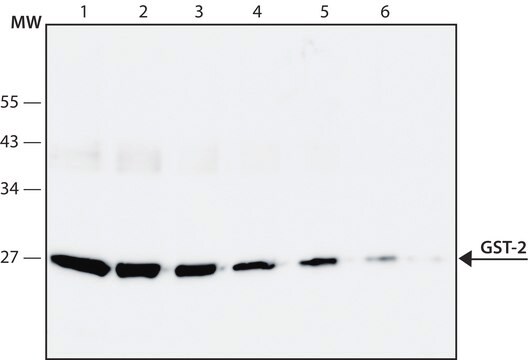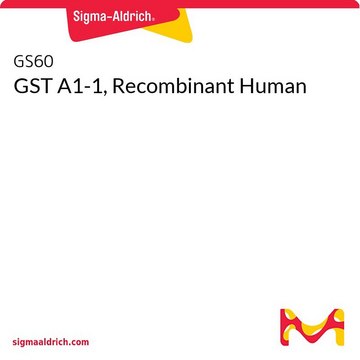CS0410
Glutathione-S-Transferase (GST) Assay Kit
sufficient for 500 multiwell tests
Sinonimo/i:
GST Enzyme Activity Kit
About This Item
Prodotti consigliati
impiego
sufficient for 500 multiwell tests
Livello qualitativo
Condizioni di spedizione
dry ice
Temperatura di conservazione
−20°C
Informazioni sul gene
human ... GSTA4(2941) , GSTM1(2944)
Descrizione generale
and erythrocyte lysates
Applicazioni
Azioni biochim/fisiol
Solo come componenti del kit
- Dulbecco's Phosphate Buffered Saline 100 mL
- L-Glutathione Reduced 1 g
- GST (Control) .1 mL
- Sample Buffer 5 mL
- Substrate (CDNB) 1.2 mL
Avvertenze
Danger
Indicazioni di pericolo
Consigli di prudenza
Classi di pericolo
Acute Tox. 2 Dermal - Acute Tox. 4 Oral - Aquatic Acute 1 - Aquatic Chronic 1 - Eye Dam. 1 - Skin Irrit. 2 - Skin Sens. 1
Codice della classe di stoccaggio
6.1A - Combustible acute toxic Cat. 1 and 2 / very toxic hazardous materials
Punto d’infiammabilità (°F)
Not applicable
Punto d’infiammabilità (°C)
Not applicable
Certificati d'analisi (COA)
Cerca il Certificati d'analisi (COA) digitando il numero di lotto/batch corrispondente. I numeri di lotto o di batch sono stampati sull'etichetta dei prodotti dopo la parola ‘Lotto’ o ‘Batch’.
Possiedi già questo prodotto?
I documenti relativi ai prodotti acquistati recentemente sono disponibili nell’Archivio dei documenti.
I clienti hanno visto anche
Il team dei nostri ricercatori vanta grande esperienza in tutte le aree della ricerca quali Life Science, scienza dei materiali, sintesi chimica, cromatografia, discipline analitiche, ecc..
Contatta l'Assistenza Tecnica.









